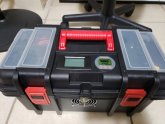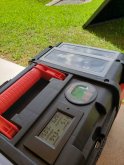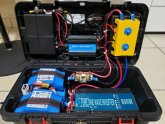NinjaDeathMonk
New Member
- Joined
- Sep 20, 2019
- Messages
- 54





Has about 825 Wh of usable power and about 650W of continuous AC output. The door on the left has wires for the solar panels, and the solar input is displayed on the left screen. The right screen displays battery capacity. The right door has wires for an external AC charger.
Main components:
- 36V 158.4Wh 10s2p Hoverboard Batteries x 6 - $180
- Reliable Power 800W Inverter - $125
- MPPT Boost Solar Charge Controller (CTKEV300) - $40
- AiLi Battery Monitor 100A - $38.50
- DROK Digital Multimeter with 100A Current Shunt - $17
- Bay Marine BusBar - $30
- Hyper Tough 19-Inch Toolbox - $12
- 42V 10A Lithium Battery Charger For 10S 36V - $58
Easily went over $600 with tools, wiring, connectors, and assorted parts. Way more if you include the prior failed attempts.
The inspiration and basis was Jehu's solar generator made from a recycled UPS and hoverboard batteries. I was going to build the UPS into a case with better airflow but I had two of them fail on me. So I decided to reinvent it with what I had and use a better quality inverter. Since I was working with 36V batteries, options were limited. The Reliable Power inverter I went with was also a dissapointment, because it doesn't perform as advertised due to a fuse limitation. Which means it can't start my fridge in case of a outage.
So I ended up with a poorly designed, over-built and under-powered solar system. At least I learned a lot in the process, including:
- I have developed a deep and powerful disdain for cutting plastic.
- I was pleasantly surprised that the solar charger performed as advertised and the batteries have been solid.
- Will was absolutely right in his video about DIY modular systems not being cost-effective these days. A lot changed in 10 months. I'll probably buy the Bluetti to power the fridge in an outage and keep this abomination around for lighting and stuff.


